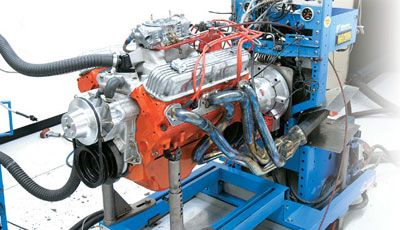
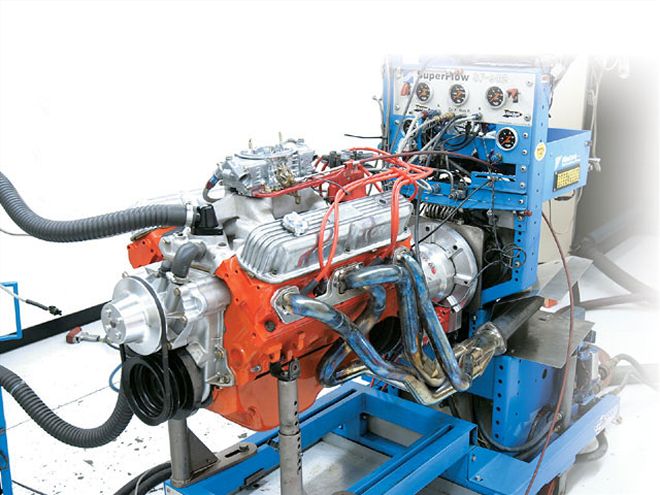
Some engines get all the glory. You know, those legendary powerplants that you can't wait to brag about. "Yep, she's got a 427..." or how about, "I'm running the hi-po 351..." or, "Sure is nice, came stock with the solid-cam LT1!" Just calling out the engine type is enough to get some respect. On the other hand, there are plenty of engines out there that will actually tempt a street hound to start lying. You know the 307 in that Chevelle, but he's tired of making excuses, and everyone just seems happier when he tells 'em it's a 327. In the world of Mopar small-blocks, the 340 basks in all the glory, and in recent years, the 360 has gained plenty of credibility, but the little 318 is generally regarded to be fairly low in the automotive pecking order. Like boat anchor low.
The fact is, with a simple combination of parts, and not a lot of money, you can consider any 318 a high-winding and stout small-block waiting to be unleashed. There are plenty of naysayers ready to explain why this can't be. They say stuff like: "Those things don't have enough cubes." But it's actually considerably bigger than the popular 5.0 Ford. "A 318's bore is too small!" Tell it to the even smaller-bore LS1 guys. "The 318 was never a high-performance engine." Maybe true, but we'll show you how to make it one!
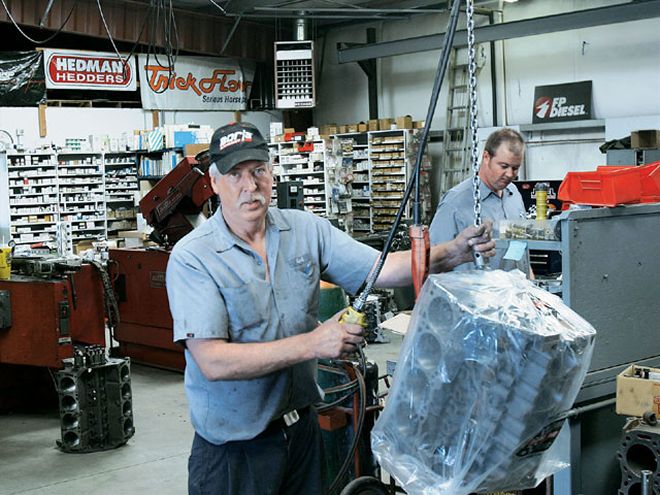 The foundation of our build is a common 318 Mopar LA-series block. We had the block prepped for a rebuild at Precision Speed and Machine in Bakersfield, CA. Machine work included boring the block .040, square decking to zero, line hone, and installing cam bearings and block plugs.
The foundation of our build is a common 318 Mopar LA-series block. We had the block prepped for a rebuild at Precision Speed and Machine in Bakersfield, CA. Machine work included boring the block .040, square decking to zero, line hone, and installing cam bearings and block plugs.
The Good And The BadIn terms of durability, the Mopar 318 is robust. The bottom end of most 318 engines used a cast-iron crankshaft, and though these are not as desirable as a forged crank, the cast-iron piece has proven to be very reliable. Early 318 engines (up to 1972) used lightweight rods with full-floating piston pins, while later engines were equipped with the heavier 340/360 forgings with press pins. The later rods are considered stronger, and this bottom end has proven very reliable in high-performance applications-especially in the street rpm range up to 6,500.
Before delving into an engine build, it's worthwhile to define the goals, and then evaluate the engine for its strengths and weaknesses to decide what will need upgrading to meet the build's objectives. First, let's look at areas where the 318 can use some help, as there are a few shortcomings that are common to these engines in stock form. Other than areas remedied by the usual bolt-ons, the factory setup fell short in three key areas: compression, camshaft, and cylinder heads. Two-barrel 318 engines were equipped with low-performance heads with small ports and valves. Later four-barrel engines, introduced in 1976, were somewhat better endowed, using the larger port and valve cylinder heads from the 360; however, these heads have larger combustion chambers that exasperate the second shortcoming of the 318-compression. A key weakness with the 318 engine is the low factory compression ratio resulting from pistons well down in the hole at TDC. Finally, all factory 318 engines were equipped with very conservative camshafts, delivering less than .400-inch lift.
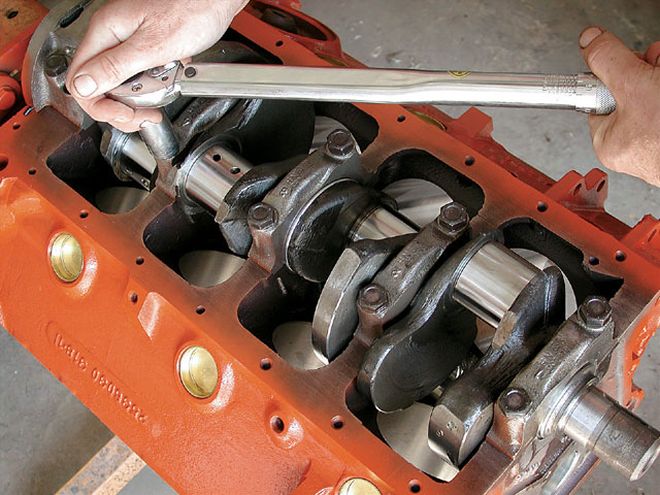 Like most 318s, ours came from the factory with a cast crank that simply needed a .010/.010 regrind. These cast cranks are plenty stout for street performance use.
Like most 318s, ours came from the factory with a cast crank that simply needed a .010/.010 regrind. These cast cranks are plenty stout for street performance use.
So, is it all bad news? Actually, in the course of a rebuild, the lack of compression ratio and camshaft can be corrected for not much more than the cost of stock replacement parts. The compression ratio side of the puzzle is quickly solved with a set of flat-top KB pistons, bringing the piston up from the depths of the bore. A modest machining of the block deck achieves a zero deck height. The KB flat-top pistons for the 318 are available in either cast hypereutectic (PN KB167) or forged (PN KB844). For the purposes of our mild street application, we opted for the more economical hypereutectic pistons.
Camshaft choices for the 318 are wide-open, but for basic street use and low cost, a hydraulic flat-tappet cam offers the greatest performance bargain. Here, the Mopar offers a potential advantage, having a .904-inch tappet diameter, which is significantly larger than that found in other popular engine makes. The larger tappet diameter allows the cam to be ground more aggressively, with a higher lift velocity, giving a power advantage in comparison to a cam designed for a smaller tappet diameter. Many off-the-shelf camshafts are designed for a minimum tappet diameter of just .842 inch (Chevy-sized), leaving some of the Mopar engine's performance potential on the shelf. We know COMP Cams offers true .904-inch tappet camshafts with their Xtreme Energy High-Lift series of cams just for Mopar engines. For our street performance small-block, we selected the most conservative of this line of camshafts, the XE275HL. Specs for this stick come to 231/237 degrees duration at .050, and .525-inch lift with a 1.5:1 rocker ratio, all on a 110-degree lobe separation angle.
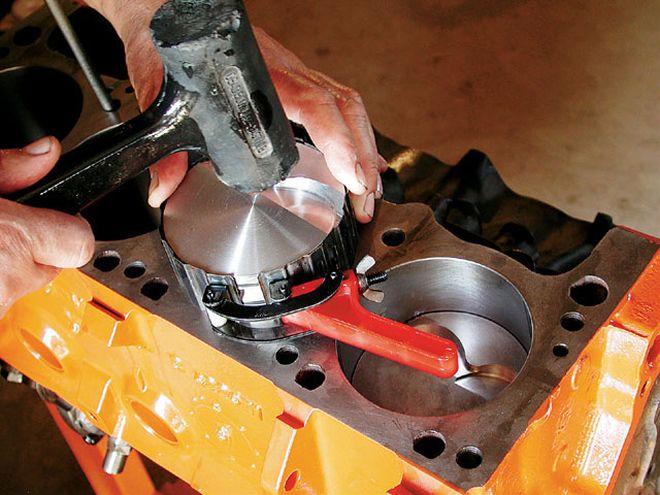 The key to our bottom-end package is the KB167 pistons, which raise the compression to a level that will support power production. These KB pistons are hypereutectic cast; however, forged pistons are also available from KB.
The key to our bottom-end package is the KB167 pistons, which raise the compression to a level that will support power production. These KB pistons are hypereutectic cast; however, forged pistons are also available from KB.
Heading For PowerThis leaves the final upgrade in our power trio of compression, cam, and cylinder heads. While good results can be had with 360-derived four-barrel 318 heads, there are some serious shortcomings. The main drawback is the large and inefficient open-style combustion chamber. Not only does this take down the compression ratio, even with the flat-top pistons, but the chamber design precludes building an engine with a desirable head-to-piston squish/quench effect. Choices in OEM cylinder heads with a closed chamber are limited to small-valve, small-port castings, or the later Magnum-style heads.
The Magnums provide some notable advantages, such as a compact modern closed chamber, generous valve sizes (1.92-inch intake, 1.625-inch exhaust), respectable port flow, and a revised valvetrain with a higher rocker ratio (1.6:1 versus 1.5:1). Converting to these cylinder heads has become a popular upgrade for earlier engines (see sidebar: "Magnum Head Conversion"); however, the main drawback with the OEM Magnum heads is a propensity for cracking. It is very difficult to find used Magnum heads that are not cracked.
Engine Quest has a viable alternative to the OEM Magnum castings with their iron Lightning cylinder heads. Essentially an OEM replacement casting, the Engine Quest heads feature refined ports and higher flow than the stock pieces, and just as importantly, these are all-new castings without the fatal Magnum head cracks. One of the traditional drawbacks of the original Magnum design was the revision with this cylinder head series to a vertical intake bolt pattern, precluding the use of readily available aftermarket manifolds designed for the earlier LA-series engines. Engine Quest addressed this compatibility issue by offering their Magnum-style replacement heads for either the Magnum-style intake (PN CH318A), or for a conventional non-Magnum-style intake (PN CH318B).
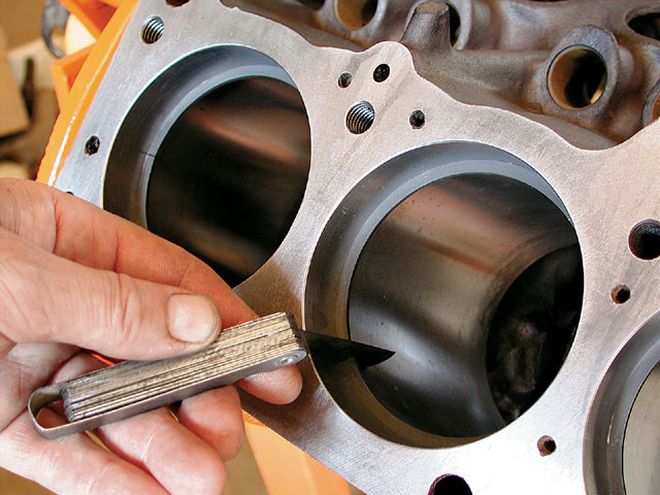 When using the hypereutectic pistons, make sure to pay attention to the special gapping instructions from KB, or catastrophic engine failure may result. The KB specs should supersede the gap specs from the ring manufacturer.
When using the hypereutectic pistons, make sure to pay attention to the special gapping instructions from KB, or catastrophic engine failure may result. The KB specs should supersede the gap specs from the ring manufacturer.
For our engine build, we opted for the CH318B castings with the earlier intake manifold bolt pattern, which is compatible with the Edelbrock Performer RPM Air-Gap intake manifold we already had. The cylinder heads were purchased as bare castings, which require assembly and valves. To fill out the castings, we went to Dr. J's Performance to have the castings assembled and dialed in. Dr. J's ordered a set of valves from SI, a manufacturer of good quality stainless steel valves at a very reasonable price. SI catalogs valves in the stock valve diameters of 1.92/1.625 inches, and the stock length. These valves take the OEM Magnum bead lock-type keepers. To complete our cylinder heads, OEM Mopar Magnum retainers and locks were used along with COMP's 901-16 valvesprings. The stock-length SI valves were set up at 1.600-inch installed height, which offers adequate coil-bind clearance with the .560-inch lift delivered by the Magnum rockers' 1.6:1 ratio. Dr. J's did find, however, that the retainer-to-guide clearance would not be sufficient, so they machined the guides to provide clearance at the guide boss.
Upon inspection of the cylinder head castings on Dr. J's flow bench, we were impressed with the out-of-the-box flow for the Engine Quest heads. Overall, the numbers were stronger than the OEM castings. If some is good, more is better, so Bryce Mulvey of Dr. J's suggested porting the Engine Quest heads. Since we wanted to test the heads in as-cast condition, we ordered a second set of heads to experiment with modifications. Bryce reported that the heads responded well to porting modifications (see sidebar: "On the Bench"). We had Dr. J's assemble a second set of the Engine Quest castings using the same hardware, but this time with basic full porting, and a set of larger 2.03/1.625-inch valves from SI.
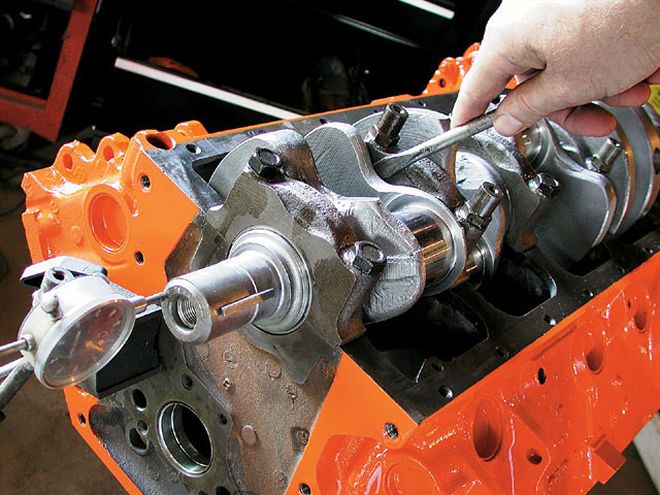 Clevite P-series bearings were used for the main and rod journals, and the crank was installed with the factory fasteners. We checked the bearing clearance at .002 inch, and the endplay measured .006.
Clevite P-series bearings were used for the main and rod journals, and the crank was installed with the factory fasteners. We checked the bearing clearance at .002 inch, and the endplay measured .006.
Assembly And Testing
With the major components ironed out, we had a core 318 block machined with a full block prep at Precision Speed and Machine in Bakersfield, California. The combination of the Engine Quest heads at 62cc combustion chamber volume, the KB pistons at zero deck, and Fel-Pro head gaskets put the engine's compression ratio at 9.85:1, a nice ratio for our street camshaft on pump gas. We had Precision resize a set of stock, later-model 318 connecting rods using ARP bolts, and fit the pistons to the rods. The stock 318 crankshaft was ground .010/.010 on the rod and main journals, and then balanced to the new parts combination. The short-block assembly was straightforward, with a stock replacement Melling oil pump and Clevite bearings. We used a set of Speed-Pro moly rings file fit to .022-inch top and .018 second. The COMP cam was lubed with moly grease, and installed at 106-degrees intake centerline using a new COMP timing set. Buttoned up with an OEM oil pan and windage tray, and a stock front cover and water pump, the bottom end of our project was completed.
Up top, we installed the Magnum-style Engine Quest heads using an LA-engine head gasket from Fel-Pro, and a set of OEM Magnum cylinder head bolts. Since all Magnum engines were originally equipped with hydraulic roller cams and our short-block is flat-tappet equipped, the combination requires longer pushrods than the stock Magnum units. We measured the required length with the stock Magnum nonadjustable rockers we were using, and ordered a set of COMP Magnum pushrods (PN 7960). The Engine Quest heads accepted all of the OEM Magnum valvetrain components without issue. We bolted on an LA-engine series Edelbrock Performer RPM Air-Gap intake manifold, and it fit the hybrid Engine Quest CH318B heads perfectly. The finishing touches included a Holley 750 HP carb and an MSD distributor and wires.
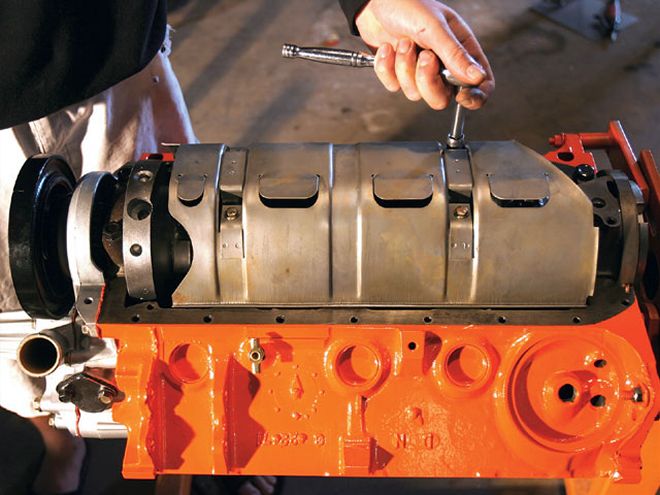 A factory windage tray went into the bottom end to help control oil. We used a stock oil pan, but improved it by welding in a fabricated baffle.
A factory windage tray went into the bottom end to help control oil. We used a stock oil pan, but improved it by welding in a fabricated baffle.
With the 318 together and ready to run, we headed over to Westech Performance Group to quantify the power at hand. Our baseline combination is a true bolt-together engine combination, using all essentially out-of-the-box parts and very little in the way of custom tricks. We spent the first few minutes of run time letting our COMP flat-tappet cam break in properly, and the engine certainly sounded healthy. With the timing set at 34 degrees, we spent considerable time dialing in the jetting, and we were pleased to see the power closing in at the 400hp mark. With the mixture set to perfection, we had a high number of 399 hp at 6,300 rpm, with the engine pulling sweetly to 6,500 rpm. The lightweight Magnum-style 5/16-inch-stem valves clearly showed better high-rpm valvetrain operation than the chunky 3/8-inch-stem units traditionally used in older LA-style engines.
We were really close to breaking the 400hp barrier, with little left to explore besides the timing. Our baseline setting is usually about optimal for a Mopar small-block; however, we pulled two degrees of timing out, for a total of 33 degrees. We dropped a few horsepower across the board. Next, we twisted the MSD distributor in the other direction, now with 36 degrees total. The engine liked the change, netting us 402 hp at 6,300 rpm. That is very good output for a street 318, with a nice use of the engine's rpm potential. While that would be enough to go home proud, we still had the Dr. J's ported heads up our sleeve. We pulled out the wrenches and tore the 318 down to a bare short-block right on the dyno.
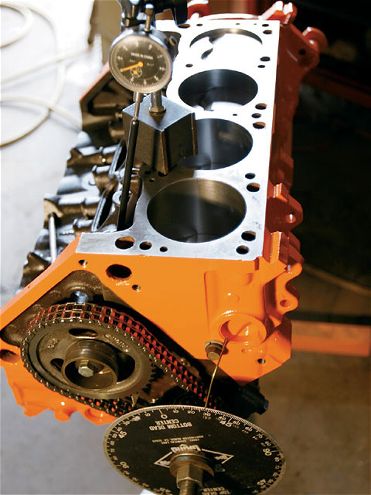 The cam was carefully degreed to the recommended 106-degree installed centerline spec. With our COMP chain, everything ended up right on the specifications without any adjustment required.
The cam was carefully degreed to the recommended 106-degree installed centerline spec. With our COMP chain, everything ended up right on the specifications without any adjustment required.
It wasn't long before our 318 was once again ready to thunder, this time with more airflow than ever. The modified heads were not substantially enlarged over the as-cast units, but the flow showed significant improvements across the board. Of interest was the larger valves, going from a 1.92-inch size to a larger 2.03 spec. Conventional wisdom would decree that the larger valves would hurt low-end torque, but we had our doubts about this commonly held belief. Our dyno graphs would tell a story here.
Once buttoned up and running, there was little to do but pull the handle for the power numbers. Interestingly, we found the torque right at the bottom to equal the initial baseline, and then the ported heads began to pull away with the torque advantage just seeming to add on as the rpms flew with as much as a 21 lb-ft advantage gained by 5,800 rpm. On the horsepower side, the ported heads just kept pulling harder up top, making full steam at 6,200 rpm at 425 hp. Ironically, that's the rated horsepower of a stock 426 Hemi; we were more than satisfied with these stout numbers from our little, overlooked 318.
Magnum Head Conversion
The Engine Quest cylinder heads are designed as a performance-improved replacement casting for the factory Magnum heads. So what makes a Magnum head a Magnum? Let's look at the changes from the earlier engine family, referred to as the LA-series engine. Magnum heads have a revised valvetrain, relying on rockers grouped on paired pedestals rather than the shaft-mounted system of earlier engines. Oiling is supplied through the pushrods via the lifters, so the lifters must have oiling provisions. Most aftermarket lifters are so equipped. Older small-blocks oil via a passage in the block feeding the rocker shaft. To go along with the rockers, the pushrod length is revised to match; we recommend measuring the actual length required for the individual engine.
Along with these changes, the Magnum castings have a revised head bolt package that does not interchange with earlier engines. At the valve cover, the machined valve cover rail takes 10 bolts rather than the LA engine's five, though the earlier valve covers will still bolt on. Another peculiarity of the Magnum is a change to vertical intake manifold fasteners, which precludes intake manifold interchange. The Engine Quest cylinder heads are available in a configuration that takes the standard early-style manifold.
On The Bench
Engine Quest Ch318b Cylinder Heads
Superflow 600 Flow Bench 28-Inch Water Depression Tested At Dr. J's Performance
On The Dyno318 Mopar Street Engine
Superflow 901 Engine Dyno Stp
Correction Factor Tested At Westech Performance Group